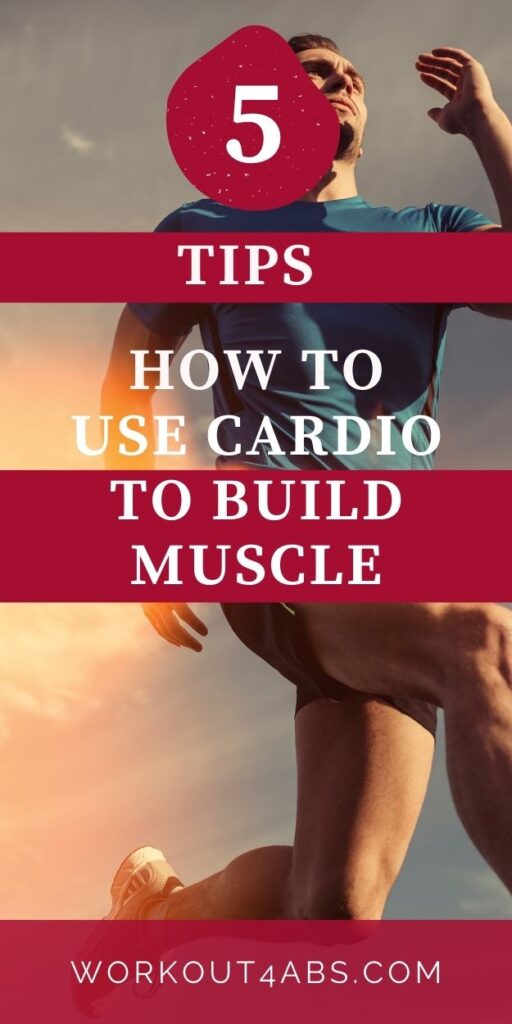Does cardio build muscle? Get your questions answered by understanding the intricate relationship between cardio exercise and muscular development is crucial. This article explores the impact of cardio on muscle gains, shedding light on why some types of cardio can bolster your progress, while others may inadvertently hinder your journey to sculpting a stronger physique. Discover the cardio strategies that can optimize your muscle-building efforts while avoiding potential setbacks.
5 Things NO ONE Tells You About Cardio & Muscle Growth
If you enjoyed these tips, please save this pin to your Pinterest Board.

Cardio May Slow Down Gains
Cardiovascular exercise, often referred to as cardio, can have both positive and negative effects on your muscle-building progress, depending on how it’s integrated into your fitness routine. Here’s how cardio exercise can potentially slow down muscle gains:
- Caloric expenditure: Cardio exercises, especially those of moderate to high intensity like running, cycling, or HIIT (High-Intensity Interval Training), can burn a significant number of calories. If you’re not careful, excessive cardio can lead to a calorie deficit, where you burn more calories than you consume. This can hinder muscle growth because your body needs a surplus of calories to build and repair muscle tissue.
- Increased energy expenditure: Intense cardio workouts can leave you feeling fatigued and reduce your overall energy levels. This fatigue may make it challenging to perform heavy resistance training, as you may not have the energy and strength required to lift heavy weights and stimulate muscle growth effectively.
- Potential muscle breakdown: Prolonged or excessive cardio, especially when performed before resistance training, can lead to muscle protein breakdown for energy, particularly if you haven’t consumed sufficient nutrients like carbohydrates and protein before your workout. This can counteract the efforts you put into building muscle.
- Competition for recovery resources: Your body has limited resources for recovery, including energy, time, and nutrients. When you engage in cardio exercise, your body allocates some of these resources to repair and adapt to the cardiovascular demands. If you overemphasize cardio in your training program, there may be fewer resources available for muscle recovery and growth.
- Elevated cortisol levels: Intense and prolonged cardio workouts can trigger the release of the stress hormone cortisol. Elevated cortisol levels can lead to muscle protein breakdown and inhibit muscle growth, especially when cardio sessions are long and frequent.
- Reduced calorie availability: Cardio can sometimes suppress your appetite, making it challenging to consume enough calories to support muscle growth. If you’re not eating enough, you won’t have the necessary nutrients to repair and build muscle tissue effectively.
To minimize the negative impact of cardio on muscle gains while still enjoying its cardiovascular benefits, consider the following strategies:
- Prioritize strength training: Make resistance training your primary focus if building muscle is your goal. Strength training should come before cardio in your workout routine to ensure you have the energy and strength required for muscle-building exercises.
- Control cardio volume and intensity: Limit the frequency, duration, and intensity of your cardio sessions to prevent excessive calorie expenditure and muscle breakdown. High-intensity interval training (HIIT) or shorter, more intense cardio workouts can be more muscle-friendly than long, steady-state cardio sessions.
- Adequate nutrition: Ensure you’re eating enough calories and nutrients to support both muscle growth and cardio performance. Consider consuming a balanced meal or snack that includes carbohydrates and protein before cardio workouts.
- Monitor recovery: Pay attention to your body’s recovery needs. Get enough sleep, practice active recovery (e.g., stretching, foam rolling), and allow your muscles to recover between workouts.
- Periodize your training: Incorporate periods of focused muscle-building training (hypertrophy phases) with periods of more intense cardio for overall fitness. This can help you achieve a balance between muscle gains and cardiovascular conditioning.
Ultimately, the impact of cardio on muscle gains varies from person to person and depends on factors such as training intensity, nutrition, and individual goals. Tailoring your exercise routine to your specific objectives and monitoring your progress can help you strike the right balance between cardio and strength training for your fitness goals.
Resistance Training Alone May be Better than Cardio/Resistance Training
Incorporating both cardio and resistance training into your workout routine can offer numerous health and fitness benefits, but it’s essential to strike the right balance to avoid negatively impacting your muscle-building goals. Here’s how doing cardio and resistance training together can potentially hinder muscle gains, and why some individuals may benefit more from focusing on resistance training alone:
- Increased calorie expenditure: Cardio exercises burn calories, and if you do them alongside resistance training without adjusting your calorie intake, you may create a calorie deficit. This means you’re burning more calories than you’re consuming, which can hinder muscle growth as your body requires a calorie surplus to build and repair muscle tissue.
- Fatigue and reduced performance: Cardio can fatigue your muscles and central nervous system, making it challenging to perform resistance exercises with the necessary intensity and focus. When you’re tired from a cardio session, you might not be able to lift as heavy or complete as many reps, limiting your muscle-building potential.
- Overtraining risk: Combining intense cardio and resistance training can increase the risk of overtraining, especially if you don’t allow sufficient time for recovery. Overtraining can lead to muscle breakdown, injuries, and decreased muscle gains.
- Muscle protein breakdown: Cardio, especially when performed before resistance training, can lead to muscle protein breakdown for energy. This can counteract the efforts you put into building and preserving muscle mass during resistance workouts.
- Conflicting adaptations: Cardio and resistance training often require different adaptations in the body. Cardio primarily focuses on improving endurance and aerobic capacity, while resistance training aims to increase muscle strength and size. Training both simultaneously can lead to conflicting adaptations and suboptimal results in either area.
However, it’s important to note that this doesn’t mean you should completely avoid combining cardio and resistance training. Many individuals successfully incorporate both into their routines while still making muscle gains. Here are some strategies to help you do so effectively:
- Prioritize resistance training: If your primary goal is muscle building, make resistance training the main focus of your workout routine. Schedule your resistance workouts before cardio sessions to ensure you have the energy and strength required for muscle-building exercises.
- Limit cardio frequency and duration: Keep your cardio sessions relatively short and infrequent to minimize calorie expenditure and muscle fatigue. High-intensity interval training (HIIT) or shorter, more intense cardio workouts can be a good option to maximize cardiovascular benefits while minimizing muscle interference.
- Monitor nutrition: Ensure you’re consuming enough calories and protein to support muscle growth, especially on days when you combine cardio and resistance training. Proper nutrition is essential to counteract the potential negative effects of cardio on muscle gains.
- Implement periodization: Consider using a periodization approach in your training program. This involves cycling through phases of focused muscle-building (hypertrophy) training and cardiovascular conditioning. During hypertrophy phases, reduce cardio to a minimum, and during conditioning phases, incorporate more cardio.
- Listen to your body: Pay attention to how your body responds to the combination of cardio and resistance training. If you notice signs of overtraining, fatigue, or stalled muscle gains, consider adjusting your training and recovery strategies.
Ultimately, the decision to include cardio alongside resistance training should align with your individual goals, preferences, and how your body responds to this combined approach. Some individuals may find that they make better progress in muscle building by prioritizing resistance training, while others may successfully integrate both types of exercise to achieve their desired fitness outcomes.
Cardio and Muscle Growth – Power and Strength is Effected Less
Cardiovascular exercise, commonly referred to as cardio, has different effects on various aspects of fitness, including muscle gains, power, and strength. When it comes to power and strength gains, cardio tends to have a relatively smaller negative impact compared to its potential impact on muscle gains. Here’s why:
- Cardio and Muscle Gains:
- Caloric expenditure: Cardio exercises can burn a significant number of calories, potentially leading to a calorie deficit. This calorie deficit can hinder muscle growth because your body needs a surplus of calories to build and repair muscle tissue.
- Muscle protein breakdown: Cardio, especially when done excessively or immediately before resistance training, can lead to muscle protein breakdown for energy. This can counteract the efforts you put into building and preserving muscle mass during resistance workouts.
- Cortisol levels: Prolonged and intense cardio workouts can lead to elevated cortisol levels, a stress hormone that can increase muscle protein breakdown and inhibit muscle growth.
- Cardio and Power/Strength Gains:
- Muscle endurance: Cardiovascular exercise can enhance your cardiovascular endurance and overall stamina, which can indirectly support power and strength gains. Improved endurance means you can sustain your efforts during strength and power-focused workouts for longer periods.
- Recovery: Cardio workouts can help with active recovery by increasing blood flow to your muscles, which may reduce muscle soreness and help you recover faster between strength and power training sessions.
- Body composition: Cardio can help control body fat levels, which can positively impact your strength-to-weight ratio. A lower body fat percentage may make it easier to move your bodyweight, potentially enhancing your power and strength in relative terms.
- Conditioning: Cardio can improve your cardiovascular conditioning, which can be beneficial for activities that require bursts of power and strength followed by rest periods, such as sports and functional training.
While cardio can have some indirect benefits for power and strength gains, it’s essential to strike a balance between cardio and resistance training to optimize your results:
- Prioritize strength training: If your primary goal is to increase power and strength, prioritize resistance training in your workout routine. Ensure you have sufficient energy and focus for your strength workouts by scheduling them before cardio sessions.
- Control cardio volume: Limit the frequency, duration, and intensity of your cardio sessions to prevent excessive calorie expenditure and muscle fatigue. High-intensity interval training (HIIT) or shorter, intense cardio sessions can be more compatible with strength and power goals.
- Monitor nutrition: Maintain an appropriate calorie intake and adequate protein consumption to support muscle recovery and growth while engaging in cardio. Proper nutrition can help mitigate the potential negative effects of cardio on muscle gains.
- Periodize your training: Consider cycling through phases that emphasize either strength and power development or cardiovascular conditioning. During strength and power phases, reduce cardio to a minimum, and during conditioning phases, incorporate more cardio.
Ultimately, the impact of cardio on power, strength, and muscle gains varies from person to person and depends on factors like training intensity, nutrition, and individual goals. A well-balanced approach to exercise and nutrition, along with regular monitoring of your progress, can help you find the right balance between cardio and resistance training to achieve your desired fitness outcomes.
If you enjoyed these tips, please save this pin to your Pinterest Board.

Greater CNS Fatigue
Aerobic exercise, such as long-duration cardiovascular workouts like running, cycling, or swimming, can lead to central nervous system (CNS) fatigue when performed at a high intensity or for an extended duration. CNS fatigue can have implications for muscle fiber recruitment and activation, especially when combined with resistance training. Here’s how this process works:
- Aerobic Exercise and CNS Fatigue:
- Increased neural demands: Aerobic exercises, especially those performed at high intensities, require a significant neural drive to coordinate muscle contractions, regulate heart rate, and maintain balance and posture. The CNS (comprising the brain and spinal cord) plays a crucial role in coordinating these functions.
- Neurotransmitter depletion: Prolonged aerobic exercise can lead to the depletion of neurotransmitters such as dopamine and serotonin, which are essential for the proper functioning of the CNS. This depletion can result in reduced CNS efficiency and increased perception of fatigue.
- Elevated stress hormones: Intense aerobic exercise can also trigger the release of stress hormones like cortisol. Elevated cortisol levels can contribute to CNS fatigue by interfering with neurotransmitter balance and reducing overall CNS function.
- Resistance Training and CNS Fatigue:
- Neural recruitment: Resistance training requires a high level of CNS involvement, especially during heavy lifts and compound movements. The CNS must recruit motor units and coordinate muscle contractions to generate force and perform resistance exercises effectively.
- Neural fatigue: After a session of resistance training, the CNS may experience fatigue, particularly when lifting heavy weights or performing strenuous exercises. This fatigue can manifest as reduced neuromuscular efficiency, decreased motor unit recruitment, and impaired motor coordination.
- Combined Effects:
- Synergistic fatigue: When you combine intense aerobic exercise and resistance training in the same workout or training program, you subject the CNS to a greater cumulative load. This can result in more significant CNS fatigue than either type of exercise performed alone.
- Impaired muscle recruitment: CNS fatigue can lead to reduced motor unit recruitment, which means fewer muscle fibers are activated during resistance exercises. This can result in decreased force production, compromised technique, and reduced overall training effectiveness.
- Decreased performance: As CNS fatigue accumulates from both aerobic and resistance training, your ability to perform at peak levels diminishes. You may find it more challenging to lift heavy weights, maintain proper form, or achieve the desired level of muscle activation, which can impact muscle growth and strength gains.
To mitigate the negative effects of CNS fatigue and optimize your training, consider the following strategies:
- Prioritize recovery: Ensure adequate rest and recovery between intense workouts, whether they involve aerobic exercise, resistance training, or both.
- Proper nutrition: Consume a balanced diet that supports recovery, including sufficient carbohydrates, protein, and micronutrients. Proper nutrition can help replenish depleted neurotransmitters and reduce stress hormone levels.
- Periodization: Structure your training program to include periods of focused aerobic conditioning and resistance training, rather than consistently performing both at high intensities. This can allow for better CNS recovery and adaptation.
- Listen to your body: Pay attention to signs of CNS fatigue, such as excessive fatigue, reduced motivation, and impaired performance. Adjust your training intensity and volume as needed to avoid overloading the CNS.
By managing CNS fatigue and balancing your training appropriately, you can minimize its negative impact on muscle fiber recruitment and activation, allowing for more effective and sustainable progress in both aerobic and resistance training.
Not All Cardio is Created Equal
When the primary goal is building muscle, it is generally advisable to avoid cardio exercises that take longer to recover from and those that cause greater central nervous system (CNS) fatigue. Here’s why:
- Prolonged Recovery from Cardio:
- Muscle recovery: Cardio exercises that take longer to recover from are typically characterized by longer durations and high-intensity efforts. These workouts can lead to muscle fatigue and may require more time for your muscles to recover fully.
- Impaired muscle growth: The extended recovery time needed after such cardio sessions can interfere with the recovery process essential for muscle growth. Your muscles require sufficient time and resources to repair and adapt to resistance training stimuli.
- Caloric expenditure: Long-duration cardio burns a significant number of calories. If not carefully managed through increased caloric intake, this can create a calorie deficit, which is not conducive to muscle building.
- Greater CNS Fatigue from Cardio:
- Neural demands: Cardio exercises that cause greater CNS fatigue often involve high-intensity interval training (HIIT) or intense, sustained efforts. These workouts place substantial neural demands on the CNS.
- Reduced neural efficiency: Excessive CNS fatigue from cardio can impair neural efficiency, making it more challenging for the CNS to recruit motor units and coordinate muscle contractions effectively during resistance training.
- Decreased muscle activation: When the CNS is fatigued from intense cardio, it may not be able to recruit as many motor units, leading to reduced muscle activation and potentially limiting the effectiveness of resistance training.
To optimize muscle-building efforts while still incorporating cardiovascular exercise into your routine, consider the following strategies:
- Prioritize resistance training: Make resistance training the primary focus of your workout routine when building muscle. Schedule resistance workouts before cardio sessions to ensure you have the energy and focus required for muscle-building exercises.
- Limit cardio duration and intensity: Choose cardio workouts that are shorter in duration and moderate in intensity, avoiding excessively long or extremely intense cardio sessions that can lead to prolonged recovery and CNS fatigue.
- Control caloric expenditure: If you’re including cardio, monitor your calorie intake to ensure you’re consuming enough to support muscle growth. Consider adjusting your nutrition to compensate for the calories burned during cardio workouts.
- Recovery strategies: Implement effective recovery strategies such as proper nutrition, adequate sleep, and active recovery techniques like stretching and foam rolling to help your muscles recover after resistance training and cardio.
- Periodization: Structure your training program with periods of focused muscle-building (hypertrophy) training, during which you minimize cardio, and conditioning phases when you incorporate more cardio. This can help you achieve a balance between muscle gains and cardiovascular fitness.
Ultimately, the key is to find a balance between resistance training and cardio that aligns with your goals and allows you to make progress in both areas while managing recovery demands and avoiding excessive CNS fatigue. Customizing your training program and closely monitoring your body’s responses will help you determine the most effective approach for your muscle-building journey.
If you enjoyed these tips, please save this pin to your Pinterest Board.

Home › Aesthetic Body Plan ›Does Cardio Build Muscle